homes
 When disaster strikes, and homes are in ruin, people try to come together to help return a sense of normalcy to the people affected by the disaster. Disasters happen quickly, and the devastation is often heavy. It is a difficult thing to help people heal. While one disaster or event is often the same as another in terms of damage, something we somehow don’t connect to that same kind of devastation, is war. I’m not sure why, but when I think of war,I picture a battle held in the middle of a vast desert, with no civilization in sight. of course, when I really think about it, I now that is not reality, but rather my mind trying to fit war into a box of civility. In reality, there is nothing civil about war. Gun shots, bombs, and land mines aren’t picky about who they hit. Soldier or civilian…all are fair game in a war. And towns…well, there is often little to nothing left after a bomb hits.
When disaster strikes, and homes are in ruin, people try to come together to help return a sense of normalcy to the people affected by the disaster. Disasters happen quickly, and the devastation is often heavy. It is a difficult thing to help people heal. While one disaster or event is often the same as another in terms of damage, something we somehow don’t connect to that same kind of devastation, is war. I’m not sure why, but when I think of war,I picture a battle held in the middle of a vast desert, with no civilization in sight. of course, when I really think about it, I now that is not reality, but rather my mind trying to fit war into a box of civility. In reality, there is nothing civil about war. Gun shots, bombs, and land mines aren’t picky about who they hit. Soldier or civilian…all are fair game in a war. And towns…well, there is often little to nothing left after a bomb hits.
During World War II, London was often the targets of the German Luftwaffe, and the bombs they dropped, devastated many parts of London. From September 7, 1940, London was systematically bombed by the Luftwaffe for 56 out of the following 57 days and nights, in what was called “The Blitz.” Most notable was a large daylight attack against London on September 15th. Of course, these weren’t the only bombings, and the people of London didn’t know when or if it was safe to be out of the bomb shelters. Life in London had taken on eerie gloom,as people continued to seek refuge in the bomb shelters, because that was the only safe place to be. The biggest problem was that the bomb shelters were also gloomy, boring, and generally depressing. The children probably suffered the most, because kids don’t really understand all this hatred and killing. Their world had been turned upside down…and they didn’t know why.
By the end of 1940, 24,000 civilians had been killed in the Blitz and hundreds of thousands made homeless. In November, German bombers had obliterated Coventry city center and there had been particularly fierce raids on Manchester and Liverpool in the days leading up to Christmas. The public were now mourning the loss of their loved ones on the home front and in combat, as well as praying for the 41,000 British soldiers captured on the continent, but it was the children, in my mind, who suffered the most. Their childlike innocence was completely destroyed, along with their homes. Their parents, and other adults made the decision to change their little world, even if it was only for a short time. They didn’t have much, but they put together whatever they could to lift the spirits of these scared children. Christmas parties were held for the children and the shelter walls were decorated with paper chains and decorations, while amateur singing nights, discussion groups, and sewing circles were held regularly.
In order to avoid the bombs, many families spent some of the holidays in air-raid shelters and other places of refuge. They decked out their temporary homes with makeshift decorations…and very short Christmas trees because of the height of the shelters. Even if gas or electricity was available, Christmas dinner would have still been an amazing feat, because turkey was so expensive. Most people made do with other cuts of meat, which were still expensive. A family of four’s weekly meat ration probably wouldn’t even cover the cost of a small chicken. One alternative was home-raised chickens or rabbits, much to the shock of young children who often regarded them as pets. Home-grown vegetables and chutneys would have also made the table. Rations were 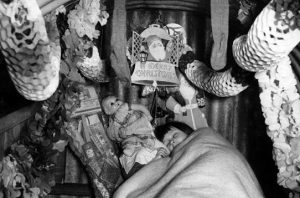 scrimped and saved including ham, bacon, butter, suet, and margarine. The tea and sugar rations were increased in the week before Christmas. Very little fruit was imported and nuts were very costly. Consequently, cooks had to improvise Christmas cakes and puddings devoid of dried fruit and marzipan, using instead sponge or other unlikely ingredients. Alcohol was available but, horribly expensive. And there would be no after-dinner French cheeses or brandy due to the German occupation. It was a poor Christmas party in comparison to those in the past, but it served to remind all the people that Christmas is more about the blessings in life, than it is about the things we are given.
scrimped and saved including ham, bacon, butter, suet, and margarine. The tea and sugar rations were increased in the week before Christmas. Very little fruit was imported and nuts were very costly. Consequently, cooks had to improvise Christmas cakes and puddings devoid of dried fruit and marzipan, using instead sponge or other unlikely ingredients. Alcohol was available but, horribly expensive. And there would be no after-dinner French cheeses or brandy due to the German occupation. It was a poor Christmas party in comparison to those in the past, but it served to remind all the people that Christmas is more about the blessings in life, than it is about the things we are given.
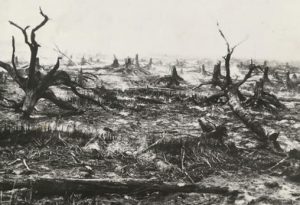 Where there is a forest, there is a possibility of a massive forest fire. The area around Moose Lake in Minnesota, had just such a fire that started on October 12, 1918. The fire, known as the Cloquet-Moose Lake fire, killed hundreds of people and leaving thousands of people homeless. The fire burned a hug area at least 1,500 square miles. The fire, which began at the rail lines near Sturgeon Lake, did the most damage in the Cloquet and Moose Lake areas. This is a region of Minnesota, north of Duluth in the eastern part of the state.
Where there is a forest, there is a possibility of a massive forest fire. The area around Moose Lake in Minnesota, had just such a fire that started on October 12, 1918. The fire, known as the Cloquet-Moose Lake fire, killed hundreds of people and leaving thousands of people homeless. The fire burned a hug area at least 1,500 square miles. The fire, which began at the rail lines near Sturgeon Lake, did the most damage in the Cloquet and Moose Lake areas. This is a region of Minnesota, north of Duluth in the eastern part of the state.
The area was really a recipe for a major disaster of this sort. The timber industry used a crude 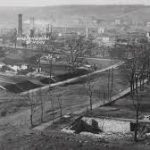 slash method in the thick forests, thus leaving behind dry scraps that were perfect kindling for wildfires. They were not careful where they left the slash either, tending to leave the scraps lying around the rail lines that carried wood from the lumber mills. Train engines of that time often gave off sparks, and when the sparks hit the slash pies, fires were nearly inevitable. The months leading up to October 1918 were very hot and dry, which made matters even worse. The fire began that October 12th, and it quickly spread due to the high winds that day. More than 200 people died in the Moose Lake area, when the fire raced into the community. Many of the local residents tried to escape the raging flames by driving down Highway 73, south of the Kettle River. The
slash method in the thick forests, thus leaving behind dry scraps that were perfect kindling for wildfires. They were not careful where they left the slash either, tending to leave the scraps lying around the rail lines that carried wood from the lumber mills. Train engines of that time often gave off sparks, and when the sparks hit the slash pies, fires were nearly inevitable. The months leading up to October 1918 were very hot and dry, which made matters even worse. The fire began that October 12th, and it quickly spread due to the high winds that day. More than 200 people died in the Moose Lake area, when the fire raced into the community. Many of the local residents tried to escape the raging flames by driving down Highway 73, south of the Kettle River. The  road had a very sharp curve that proved to be too difficult to maneuver for drivers who were speeding away from the flames surrounding them. At least 15 vehicles went off the road within minutes, which resulted in 25 deaths.
road had a very sharp curve that proved to be too difficult to maneuver for drivers who were speeding away from the flames surrounding them. At least 15 vehicles went off the road within minutes, which resulted in 25 deaths.
In all, he fire destroyed 38 towns and villages. The total dead was 453 and another 85 people were seriously burned. The area lost 4,000 houses, 6,000 barns, and 40 schools to the flames.The fire came up so quickly that there was no time to try to get the livestock out, and hundreds of thousands of farm animals also perished in the fire. It was a huge loss for area farmers. In all, the region suffered close to $100 million in damages.
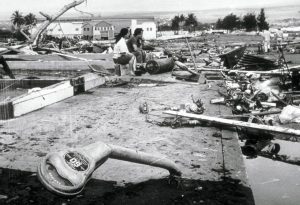 These days, scientist and inventors have collaborated to develop early warning systems for just about any possible disaster, and when everything works as it should, and people heed the warnings, loss of life can often be avoided. Having the technology is great, but technology can’t make human beings do the right things…unfortunately. On May 22, 1960, twelve years after tsunami warnings were developed, and with the warning system in good working order, a massive 9.5 earthquake struck off the coast of Chili. It was the largest earthquake ever recorded. Unfortunately, we don’t really have an earthquake warning, and so without warning, 1655 people lost their lives in Chili and 3,000 injured in the quake. Two million people were made homeless, and damage was estimated at $550 million. The earthquake, involving a severe plate shift, caused a large displacement of water off the coast of southern Chile at 3:11pm. Traveling at speeds in excess of 400 miles per hour, the tsunami moved west and north. On the west coast of the United States, the waves caused an estimated $1 million in damages, but were not deadly. Everyone assumed that the worst was over.
These days, scientist and inventors have collaborated to develop early warning systems for just about any possible disaster, and when everything works as it should, and people heed the warnings, loss of life can often be avoided. Having the technology is great, but technology can’t make human beings do the right things…unfortunately. On May 22, 1960, twelve years after tsunami warnings were developed, and with the warning system in good working order, a massive 9.5 earthquake struck off the coast of Chili. It was the largest earthquake ever recorded. Unfortunately, we don’t really have an earthquake warning, and so without warning, 1655 people lost their lives in Chili and 3,000 injured in the quake. Two million people were made homeless, and damage was estimated at $550 million. The earthquake, involving a severe plate shift, caused a large displacement of water off the coast of southern Chile at 3:11pm. Traveling at speeds in excess of 400 miles per hour, the tsunami moved west and north. On the west coast of the United States, the waves caused an estimated $1 million in damages, but were not deadly. Everyone assumed that the worst was over. 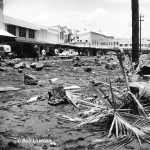
Nevertheless, warnings were sent to the Hawaiian islands. The Pacific Tsunami Warning System properly and warnings were issued to Hawaiians six hours before the wave’s expected arrival. The response of some people, however, was reckless and irresponsible. Some people ignored the warnings, and others actually headed to the coast in order to view the wave. Arriving 15 hours after the quake, only a minute after predicted, the tsunami destroyed Hilo Bay, on the island of Hawaii. Thirty five foot waves bent parking meters to the ground and wiped away most buildings, destroying or damaging more than 500 homes and businesses. A 10 ton tractor was swept out to sea. Reports indicate that the 20 ton boulders making up the sea wall were moved 500 feet. Sixty-one people died in Hilo, the worst-hit area of the island chain. Damage was estimated at $75 million. This tsunami caused little damage elsewhere in the islands, where wave heights were in the 3-17 foot range. The tsunami continued to race further west across the Pacific. Ten thousand miles away from the earthquake’s epicenter. Japan, received warning, but wasn’t able to warn the people in harm’s way. At about 6pm, more than a day after the quake, the tsunami hit the Japanese islands of Honshu and Hokkaido. The  crushing wave killed 180 people, left 50,000 more homeless and caused $400 million in damages. The Philippines, also hit, saw 32 people dead or missing.
crushing wave killed 180 people, left 50,000 more homeless and caused $400 million in damages. The Philippines, also hit, saw 32 people dead or missing.
Tsunami warnings definitely save lives, but only if people will heed the warnings. As long as people decide that the warning doesn’t apply to them, and give in to their curiosity to go have a look, there will continue to be deaths. It seems a great shame that inventors and scientist work so hard to make a warning to save lives, and then some people refuse to do what is necessary to be safe after they have been warned. I simply don’t understand how people can ignore these warnings and take a chance with their lives.
 During World War II, many children lost their parents to hunger or bombings. Many of the orphanages were either overcrowded or non-existent. To save them from starvation, many Russian military units adopted the orphans. I’m not sure what the units did with the children while they were fighting, but my guess is that some of them wrote home to their wives and told them that they wanted to adopt these little cuties.
During World War II, many children lost their parents to hunger or bombings. Many of the orphanages were either overcrowded or non-existent. To save them from starvation, many Russian military units adopted the orphans. I’m not sure what the units did with the children while they were fighting, but my guess is that some of them wrote home to their wives and told them that they wanted to adopt these little cuties.
Two year old Lucy was adopted by Russian sailors of the Baltic Fleet after her parents died during the siege of Leningrad. Of course, she was too young to really remember her parents, and so whoever ended up adopting her would become her parents in her mind. Little is known about what happened to Lucy after this picture was taken, but if she is still alive, she would be in her mid-seventies now.
Of course, not all children were as blessed to find homes. One orphaned boy who had to live in a foster home wrote in a small notebook about how many of his friends were dying of hunger, and at the same time he drew “amazing” images of food such as “ham and chicken” in the pages of his diary. I guess he was trying to remind himself about the good old days…when food was abundant and his parents were still alive.
People who were living in Leningrad during the siege went through the worst of times. In all, the siege lasted 900 days (almost 2½ years). Food was scarce, and the people withered away. They could not escape and they could not bring in supplies. Eventually, people began to die. In all, more than a million civilians died during those horrible days. Lucy’s parents were among those who didn’t make it, probably because they gave what 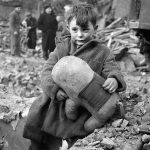 little food they had to her. I can’t imagine what must have gone through their minds. They must have agonized over the instinct to do whatever it took to keep their child alive, and wondering what would happen to her if they died and left her orphaned.
little food they had to her. I can’t imagine what must have gone through their minds. They must have agonized over the instinct to do whatever it took to keep their child alive, and wondering what would happen to her if they died and left her orphaned.
I wish there was a way to find out what happened to Lucy. I hope she had a good life with loving parents, who gave her the kind of life her own parents would have given her, had they lived. I hope she grew up to have a husband and children of her own. And I hope that her adoptive parents told her about the parents who loved her so much that they allowed themselves to starve to death, that she might live. Such a sacrifice should not go unnoticed, nor should it ever be forgotten.
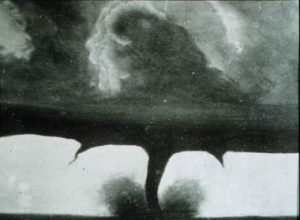 These days, tornado watches and warnings are a normal part of life. They may not happen every day, but when they do sound, we know what to do to stay as safe as possible. The warnings don’t always mean that there are zero deaths from a tornado, but they do help. Unfortunately, the tornado warning sirens, Doppler radar, and television warnings did not exist in 1884. In those days, people had to rely on the skies to tell them what was coming, and as most of us know, that is not always an easy task. In fact, it has taken hundreds of years to even begin to come close to perfecting a system whereby the public could be warned of approaching severe weather, and even then, it hasn’t eliminated the deaths that can occur from these storms.
These days, tornado watches and warnings are a normal part of life. They may not happen every day, but when they do sound, we know what to do to stay as safe as possible. The warnings don’t always mean that there are zero deaths from a tornado, but they do help. Unfortunately, the tornado warning sirens, Doppler radar, and television warnings did not exist in 1884. In those days, people had to rely on the skies to tell them what was coming, and as most of us know, that is not always an easy task. In fact, it has taken hundreds of years to even begin to come close to perfecting a system whereby the public could be warned of approaching severe weather, and even then, it hasn’t eliminated the deaths that can occur from these storms.
One of the largest and most widespread tornado outbreaks in American history happened at a time when warnings did not exist. It happened on this day February 19, 1884, and into February 20, 1884. The precise number of tornadoes, as well as fatalities incurred during the outbreak remains unknown. The outbreak was nicknamed “Enigma outbreak” and is well known by that name. Research of newspaper reports and governmental studies published in the aftermath reveals tornadoes, or in reality, long-track tornado families, struck Alabama,  Georgia, Illinois, Indiana, Kentucky, Mississippi, North Carolina, South Carolina, Tennessee and Virginia. It is estimated that at least 50 tornadoes struck those states that day. Some events that had been counted as tornadoes in initial studies, such as those by John Park Finley, were actually downbursts, especially in northern and northeastern portions of the outbreak. Nevertheless, the damage done was nothing to be overlooked.
Georgia, Illinois, Indiana, Kentucky, Mississippi, North Carolina, South Carolina, Tennessee and Virginia. It is estimated that at least 50 tornadoes struck those states that day. Some events that had been counted as tornadoes in initial studies, such as those by John Park Finley, were actually downbursts, especially in northern and northeastern portions of the outbreak. Nevertheless, the damage done was nothing to be overlooked.
The majority of the reported tornadic activity was seen across Alabama, Georgia, South Carolina and North Carolina, which were all struck severely by multiple waves of tornado families. In the Southeast, the outbreak began during the late morning in Mississippi, preceded by severe thunderstorms in Louisiana. Shortly thereafter, the outbreak widened and intensified, progressing from Alabama to Virginia between noon and midnight. In addition to the outbreak, wind damage, flash floods, with homes swept away by water in Louisville, Kentucky, New Albany, Indiana, and Jeffersonville, Indiana and other towns along the Ohio River, and Derecho-like effects in the Ohio Valley were also reported in published accounts of the outbreak. In case you didn’t know, a Derecho is a widespread, long-lived, straight-line wind storm that is  associated with a land-based, fast-moving group of severe thunderstorms. In addition to that, blizzard conditions occurred in the eastern Midwest, as a part of this storm series. According to an article appearing in the Statesville, North Carolina Landmark three days later, the damage tally in Georgia alone was estimated to be $1 million, in 1884 dollars. Today, the damage would have been approximately $23,660,667. That is an astounding figure, and that is just the property damage numbers. Loss of life simply cannot be measured in money. In fact, the greatest mystery surrounding this horrific event is the possibility that, in all likelihood, as many as 1,200 people lost their lives that day at the hands of the 1884 Enigma Tornado Outbreak.
associated with a land-based, fast-moving group of severe thunderstorms. In addition to that, blizzard conditions occurred in the eastern Midwest, as a part of this storm series. According to an article appearing in the Statesville, North Carolina Landmark three days later, the damage tally in Georgia alone was estimated to be $1 million, in 1884 dollars. Today, the damage would have been approximately $23,660,667. That is an astounding figure, and that is just the property damage numbers. Loss of life simply cannot be measured in money. In fact, the greatest mystery surrounding this horrific event is the possibility that, in all likelihood, as many as 1,200 people lost their lives that day at the hands of the 1884 Enigma Tornado Outbreak.
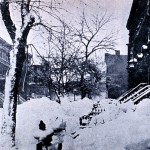 As we sit here, with an early Spring upon us, I find it an odd thing to think about another year that had been rather balmy too. The year was 1888, and things were about to get serious along the northern East Coast. The day began with rain, but as the storm really came at around midnight, the rain turned to snow, and the area began to become a nightmare right before the very eyes of the people in the area. Snowfalls of between 20 to 60 inches were seen in parts of New Jersey, New York, Massachusetts, and Connecticut. The winds howled…sustained winds of more than 45 miles per hour producing snowdrifts in excess of 50 feet. The area railroads were shut down and people were confined to their houses for up to a week. The difficult thing here is that people didn’t have some of the weather predictors that we have these days, so many of them had no idea what was coming their way, and so had far k=less time to prepare for it.
As we sit here, with an early Spring upon us, I find it an odd thing to think about another year that had been rather balmy too. The year was 1888, and things were about to get serious along the northern East Coast. The day began with rain, but as the storm really came at around midnight, the rain turned to snow, and the area began to become a nightmare right before the very eyes of the people in the area. Snowfalls of between 20 to 60 inches were seen in parts of New Jersey, New York, Massachusetts, and Connecticut. The winds howled…sustained winds of more than 45 miles per hour producing snowdrifts in excess of 50 feet. The area railroads were shut down and people were confined to their houses for up to a week. The difficult thing here is that people didn’t have some of the weather predictors that we have these days, so many of them had no idea what was coming their way, and so had far k=less time to prepare for it.
Areas of northern Vermont received from 20 inches to 30 inches in this storm, with drifts reported from 30 to 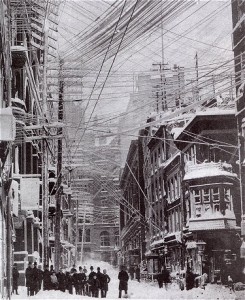 40 feet over the tops of houses from New York to New England. There were also reports of drifts covering 3 story houses. The highest drift…52 feet was recorded in Gravesend, New York. A total of 58 inches of snow fell in Saratoga Springs, New York; 48 inches in Albany, New York; 45 inches of snow in New Haven, Connecticut; and 22 inches of snow in New York City. With the snow came severe winds, with gusts up to 80 miles per hour, although the highest official report in New York City was 40 miles per hour, with a 54 miles per hour gust reported at Block Island. Central Park Observatory, in New York City, reported a low temperature of 6 °F, and a high temperature of 9 °F on March 13…the coldest ever for March. These days Winter Storms have names, but they didn’t then. Nevertheless, the storm was named the Great White Hurricane. It paralyzed the East Coast from the Chesapeake Bay to Maine, as well as the Atlantic provinces of Canada. The Telegraph was disabled because of all the downed lines, isolating Montreal and most of the large northeastern United States cities from Washington DC to Boston for days. Following the storm, New York began placing its telegraph and telephone lines underground to prevent destruction. From Chesapeake Bay through the New England area, more than 200 ships were either grounded or wrecked, killing at least 100 seamen.
40 feet over the tops of houses from New York to New England. There were also reports of drifts covering 3 story houses. The highest drift…52 feet was recorded in Gravesend, New York. A total of 58 inches of snow fell in Saratoga Springs, New York; 48 inches in Albany, New York; 45 inches of snow in New Haven, Connecticut; and 22 inches of snow in New York City. With the snow came severe winds, with gusts up to 80 miles per hour, although the highest official report in New York City was 40 miles per hour, with a 54 miles per hour gust reported at Block Island. Central Park Observatory, in New York City, reported a low temperature of 6 °F, and a high temperature of 9 °F on March 13…the coldest ever for March. These days Winter Storms have names, but they didn’t then. Nevertheless, the storm was named the Great White Hurricane. It paralyzed the East Coast from the Chesapeake Bay to Maine, as well as the Atlantic provinces of Canada. The Telegraph was disabled because of all the downed lines, isolating Montreal and most of the large northeastern United States cities from Washington DC to Boston for days. Following the storm, New York began placing its telegraph and telephone lines underground to prevent destruction. From Chesapeake Bay through the New England area, more than 200 ships were either grounded or wrecked, killing at least 100 seamen.
In New York, all transportation was at a standstill for days, and drifts across the New York–New Haven rail line at Westport, Connecticut took eight days to clear. Partly because of the transportation gridlock, it was decided that they needed a better system, and the first underground subway system in the United States, opened nine years later in 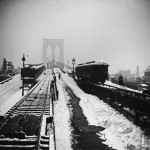 Boston. The New York Stock Exchange was closed for two days…something that almost never happens. Firefighters were unable to get to the fires, and property loss just from the fires was estimated at $25 million. Severe flooding occurred after the storm due to melting snow, especially in the Brooklyn area, which was more susceptible to serious flooding. Efforts were made to push the snow into the Atlantic Ocean. More than 400 people died from the storm and the cold that came with it, including 200 in New York City alone. Among them was former United States Senator Roscoe Conkling. The blizzard also resulted in the founding of the Christman Bird and Wildlife Sanctuary located near Delanson, Schenectady County, New York, which was listed on the National Register of Historic Places in 1970.
Boston. The New York Stock Exchange was closed for two days…something that almost never happens. Firefighters were unable to get to the fires, and property loss just from the fires was estimated at $25 million. Severe flooding occurred after the storm due to melting snow, especially in the Brooklyn area, which was more susceptible to serious flooding. Efforts were made to push the snow into the Atlantic Ocean. More than 400 people died from the storm and the cold that came with it, including 200 in New York City alone. Among them was former United States Senator Roscoe Conkling. The blizzard also resulted in the founding of the Christman Bird and Wildlife Sanctuary located near Delanson, Schenectady County, New York, which was listed on the National Register of Historic Places in 1970.
 For years many Americans, myself included, were drawn into the Korean War, or at least one aspect of it, in the form of M*A*S*H, a popular television show about the way a Mobile Army Surgical Hospital was run…sort of. The show took on more than just the hospital side, by including a comical side that portrayed the antics of Benjamin Franklin Pierce, aka Hawkeye, and his best friend and co-conspirator, BJ Honeycutt. I can’t say just how true to life the show was, but we all cried right along with the doctors and nurses when they lost a patient, and cheered when they saved one.
For years many Americans, myself included, were drawn into the Korean War, or at least one aspect of it, in the form of M*A*S*H, a popular television show about the way a Mobile Army Surgical Hospital was run…sort of. The show took on more than just the hospital side, by including a comical side that portrayed the antics of Benjamin Franklin Pierce, aka Hawkeye, and his best friend and co-conspirator, BJ Honeycutt. I can’t say just how true to life the show was, but we all cried right along with the doctors and nurses when they lost a patient, and cheered when they saved one.
In reality, the MASH units were a vital part of the war effort, and the saving of  the lives of many soldiers. These were amazing surgeons who learned techniques that cut corners, making surgeries faster and more efficient, bringing lifesaving changes to medicine in the process. The MASH units were originally established in August of 1945, and then were deployed during the Korean War and later conflicts. The Army deactivated the last MASH unit on February 16, 2006, which I did not know, but I’m sure most of my military friends probably did. The MASH units were replaced by the CSH or Combat Support Hospital. I’m sure the CSH units are amazing units too, and maybe someday they will have as big a place in history as the MASH units did, but unless they do a television show that is as popular as the M*A*S*H show was, I don’t think their place in history will be as well known to the American people as the MASH units were. I’m sure that with all the improvements, the CHS units are probably better and more up to date than the MASH units were, but in the hearts of the M*A*S*H fans, the CHS units have big shoes to fill.
the lives of many soldiers. These were amazing surgeons who learned techniques that cut corners, making surgeries faster and more efficient, bringing lifesaving changes to medicine in the process. The MASH units were originally established in August of 1945, and then were deployed during the Korean War and later conflicts. The Army deactivated the last MASH unit on February 16, 2006, which I did not know, but I’m sure most of my military friends probably did. The MASH units were replaced by the CSH or Combat Support Hospital. I’m sure the CSH units are amazing units too, and maybe someday they will have as big a place in history as the MASH units did, but unless they do a television show that is as popular as the M*A*S*H show was, I don’t think their place in history will be as well known to the American people as the MASH units were. I’m sure that with all the improvements, the CHS units are probably better and more up to date than the MASH units were, but in the hearts of the M*A*S*H fans, the CHS units have big shoes to fill.
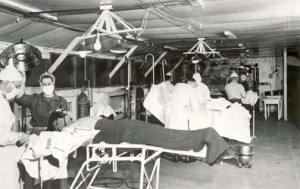 Many an evening has found Bob and I watching a M*A*S*H marathon. And during the original years, we watched it every night that it was on. We simply liked the show. I have to wonder if any other war has been watched as much as the Korean War…even though people didn’t necessarily realize that they were watching a war, or at least a part of it. While we may not have really learned a lot about the Korean War from this source, we did learn something about one part of the war…a vital part in all reality. Now that M*A*S*H is on again as re-runs, we often fine ourselves watching it again…even though we know how it will end. It is just one of those timeless shows. You just really never get tired of them…even the re-runs.
Many an evening has found Bob and I watching a M*A*S*H marathon. And during the original years, we watched it every night that it was on. We simply liked the show. I have to wonder if any other war has been watched as much as the Korean War…even though people didn’t necessarily realize that they were watching a war, or at least a part of it. While we may not have really learned a lot about the Korean War from this source, we did learn something about one part of the war…a vital part in all reality. Now that M*A*S*H is on again as re-runs, we often fine ourselves watching it again…even though we know how it will end. It is just one of those timeless shows. You just really never get tired of them…even the re-runs.
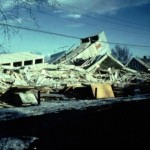
 While my husband, Bob and I were in Anchorage, Alaska recently, we went to the area visitor’s center, where we watched a movie about the 1964 Great Alaska Earthquake that occurred there. It was the largest earthquake in the history of the United States, registering 9.2 on the Richter Scale. The earthquake occurred on March 27, 1964 at 5:36pm, just 5 years after Alaska became the 49th state. It was Good Friday, and a lot of places had closed early for the holiday…a fact credited for savings lives. The death toll was relatively low, at 131…most of whom were killed by the tsunami that followed the quake. That number is amazing when you consider the magnitude of the quake. The property damage, was a very different thing. The main street became two levels. The school split into two sections, homes were leveled, and streets were split down the middle. All that is common in earthquakes…especially of that magnitude, but there were some things that were less common.
While my husband, Bob and I were in Anchorage, Alaska recently, we went to the area visitor’s center, where we watched a movie about the 1964 Great Alaska Earthquake that occurred there. It was the largest earthquake in the history of the United States, registering 9.2 on the Richter Scale. The earthquake occurred on March 27, 1964 at 5:36pm, just 5 years after Alaska became the 49th state. It was Good Friday, and a lot of places had closed early for the holiday…a fact credited for savings lives. The death toll was relatively low, at 131…most of whom were killed by the tsunami that followed the quake. That number is amazing when you consider the magnitude of the quake. The property damage, was a very different thing. The main street became two levels. The school split into two sections, homes were leveled, and streets were split down the middle. All that is common in earthquakes…especially of that magnitude, but there were some things that were less common.
At the Alaska Wildlife Conservation Center, there exists a stand of dead trees. It might make sense to cut these trees down, but it would not be an easy thing to do. The ground dropped 10 feet in the 1964 earthquake, and the influx of salt water from 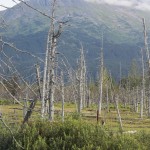
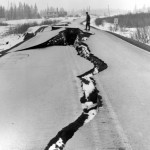 the inlet killed the trees…petrifying them at the same time. To cut the trees down takes approximately 4 hours per tree, and seemed too impossible a job to tackle. The settlement of Portage, Alaska sank six feet, putting it below sea level. The town doesn’t really exist now, except as a ghost town. Everyone has had to relocate to nearby high ground.
the inlet killed the trees…petrifying them at the same time. To cut the trees down takes approximately 4 hours per tree, and seemed too impossible a job to tackle. The settlement of Portage, Alaska sank six feet, putting it below sea level. The town doesn’t really exist now, except as a ghost town. Everyone has had to relocate to nearby high ground.
But the area that hit me the most was an area called Earthquake Park. The four minutes that the earthquake rattled the area caused the Turnagain Heights neighborhood to virtually disappear. I guess the damage to that area is technically a landslide, but it was really more of a wave motion. During those four minutes, the land rolled up and down like a roller coaster. When the quake was over, many of the homes in that neighborhood had been literally swallowed up by the quake. As we looked at the area during our city tour and again as we walked the Tony Knowles Coastal Trail, it felt so strange to me. Our guide told us that if you walked through the land that went uphill and then down hill, just like a wave, you could still see chimneys sticking up out of the ground, where the home that was attached to them had literally disappeared beneath the earth. I simply couldn’t imagine what it must have been like to have the home you 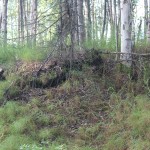
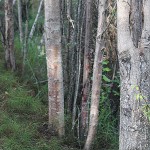 were in, be swallowed up by the earth. I was not able to get any death toll that was specific to the Turnagain Heights area, but with so many people home for the coming holiday, I think there must have been several or even more. It’s hard to describe what I felt in the Earthquake Park area, but I guess it was a mixture of awe and loss. I don’t know how that much devastation could occur on a holiday weekend, with no loss of life. The area felt like you needed to be quiet…as a show of respect maybe. I can’t really say exactly, I just know that it is a place I will not soon forget.
were in, be swallowed up by the earth. I was not able to get any death toll that was specific to the Turnagain Heights area, but with so many people home for the coming holiday, I think there must have been several or even more. It’s hard to describe what I felt in the Earthquake Park area, but I guess it was a mixture of awe and loss. I don’t know how that much devastation could occur on a holiday weekend, with no loss of life. The area felt like you needed to be quiet…as a show of respect maybe. I can’t really say exactly, I just know that it is a place I will not soon forget.
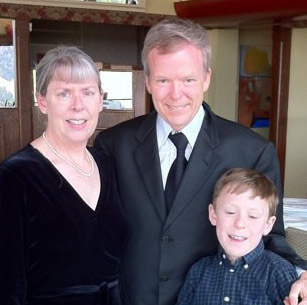 I have been intently watching the flooding this past week in Colorado, and especially Boulder, which is very near where my cousin Tim and his family live. Rain has poured into the state, and the flooding rivals the July 31, 1976 Big Thompson flood in many areas. In that flood, 12 to 14 inches of rain fell in 4 hours, flooding the canyon…144 people lost their lives, and 150 were injured. So far in this flood, only 4 people have died, thankfully, and hopefully that will be all, but only time will tell. Roads have been washed out, and I-25 is under water in some areas, causing it’s closure along with the closure of many other roads. Neighbors have stepped up to help save the homes of other people, some of whom they don’t even know, and often working for hours without even being asked. It has been a real show of the human spirit and its ability to care for those in need. Outside help is probably scarce, because no one can get there, leaving them somewhat isolated, except for helicopters that have been able to come in from other areas. Schools are closed, and many people have been told not to attempt to go to work. Two people were
I have been intently watching the flooding this past week in Colorado, and especially Boulder, which is very near where my cousin Tim and his family live. Rain has poured into the state, and the flooding rivals the July 31, 1976 Big Thompson flood in many areas. In that flood, 12 to 14 inches of rain fell in 4 hours, flooding the canyon…144 people lost their lives, and 150 were injured. So far in this flood, only 4 people have died, thankfully, and hopefully that will be all, but only time will tell. Roads have been washed out, and I-25 is under water in some areas, causing it’s closure along with the closure of many other roads. Neighbors have stepped up to help save the homes of other people, some of whom they don’t even know, and often working for hours without even being asked. It has been a real show of the human spirit and its ability to care for those in need. Outside help is probably scarce, because no one can get there, leaving them somewhat isolated, except for helicopters that have been able to come in from other areas. Schools are closed, and many people have been told not to attempt to go to work. Two people were 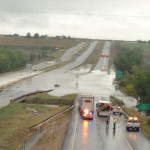 stranded in the mountains in whiteout conditions, because
stranded in the mountains in whiteout conditions, because 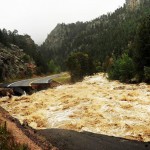 rescue resources were limited. They were rescued after 48 hours in the storm. Tim told me that the barrel they have in their back yard, to measure the rain, shows 10 inches over 3 days, with most of it coming over a 12 hour period. The huge snow storm in the mountains could cause continuing problems if it begins to melt.
rescue resources were limited. They were rescued after 48 hours in the storm. Tim told me that the barrel they have in their back yard, to measure the rain, shows 10 inches over 3 days, with most of it coming over a 12 hour period. The huge snow storm in the mountains could cause continuing problems if it begins to melt.
This flood also reminded me of an old photograph in my grandmother’s album. I’m not sure where this taken, but it does appear that they had quite a bit of water. Sadly, in those days, homes weren’t sealed as well, and so I’m sure there was extensive damage. Add to that, the fact that they didn’t have some of the clean up tools and chemicals to prevent mold, and you have a recipe for a big mess. They also didn’t have warning systems to tell them of the possiblity of a flash flood, and there were may people who lost their lives in 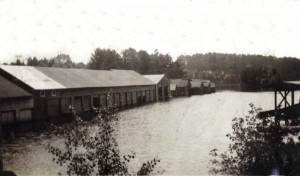 those situations. The things that have not changed over the years are the incredible human spirit and peoples’ will to survive. Neighbors will continue to help their neighbors, and people will fight to survive and rebuild their lives after each new disaster hits them. Floods are one of the most dangerous situations people can be in, and I am thankful that we have resources today to help more and more of them survive that danger. I will continue to pray for all those people who’s lives have been touched by the 2013 Colorado floods.
those situations. The things that have not changed over the years are the incredible human spirit and peoples’ will to survive. Neighbors will continue to help their neighbors, and people will fight to survive and rebuild their lives after each new disaster hits them. Floods are one of the most dangerous situations people can be in, and I am thankful that we have resources today to help more and more of them survive that danger. I will continue to pray for all those people who’s lives have been touched by the 2013 Colorado floods.
 Ranger, Texas had been an agricultural center, becoming a wheat producing center for the north, until a drought in 1917 hit the town crops very hard. That was when a few residents encouraged William Knox Gordon (who could be relation to Bob’s family, but I have not confirmed it) who was vice president of the Texas Pacific Coal and Oil Company, to test for oil in the area. He found oil, but the first well drilled, the Nannie Walker No. 1, was somewhat of a disappointment, as it first produced gas and only later blew in oil. Then, in October 1917 the McClesky No. 1 came in, reached a daily production of 1,700 barrels, and began a mammoth oil boom
Ranger, Texas had been an agricultural center, becoming a wheat producing center for the north, until a drought in 1917 hit the town crops very hard. That was when a few residents encouraged William Knox Gordon (who could be relation to Bob’s family, but I have not confirmed it) who was vice president of the Texas Pacific Coal and Oil Company, to test for oil in the area. He found oil, but the first well drilled, the Nannie Walker No. 1, was somewhat of a disappointment, as it first produced gas and only later blew in oil. Then, in October 1917 the McClesky No. 1 came in, reached a daily production of 1,700 barrels, and began a mammoth oil boom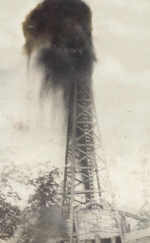 that drastically changed Ranger and Eastland County.
that drastically changed Ranger and Eastland County.
In the summer of 1918, my grandparents sold their homestead in Minnesota and headed south, finally settling in the town of Ranger, Texas. Like so many people, the oil boom in Ranger had drawn them in search of better times, and oil meant better times. There were many oil wells near and even in the town of Ranger during those years, and that meant that the residents could never escape the smell of oil. That is something we here in Wyoming can understand…or at least any of us who have been through the town of Midwest. You know you are getting close to Midwest, because your proximity is announced by the pungent smell of oil. I suppose if you are an oil tycoon, that might just smell like money, but to me…it smells awful.
During those years, there was a danger that the people of Ranger lived with every day. With so much drilling going on, so close and within the town and with the drought continuing, the possibility of out of control fires when an oil well came in and caught fire was a daily concern. There were several such fires, including the one on April 6, 1919, which took out 2 city blocks in the town. It is hard for me to think about how my grandmother must have felt with those fires being a daily possibility…especially after the one that happened on April 6th. 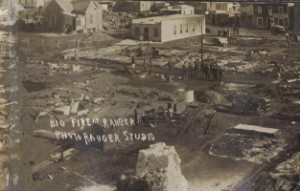 My Aunt Laura was just a little girl of 6 years when the April 6th fire hit the town. The worry of trying to get your little girl out of harms way, must have weighed heavy on my grandparents’ minds. She could be outside playing with friends, or sleeping, or any number of other reasons that could make a quick escape difficult. Nevertheless, the little family survived that constant threat of fires and after getting their fill of the Texas oil fields, returned to Wisconsin, at some point before my Uncle Bill was born in 1922, where they would remain for the rest of their lives.
My Aunt Laura was just a little girl of 6 years when the April 6th fire hit the town. The worry of trying to get your little girl out of harms way, must have weighed heavy on my grandparents’ minds. She could be outside playing with friends, or sleeping, or any number of other reasons that could make a quick escape difficult. Nevertheless, the little family survived that constant threat of fires and after getting their fill of the Texas oil fields, returned to Wisconsin, at some point before my Uncle Bill was born in 1922, where they would remain for the rest of their lives.

